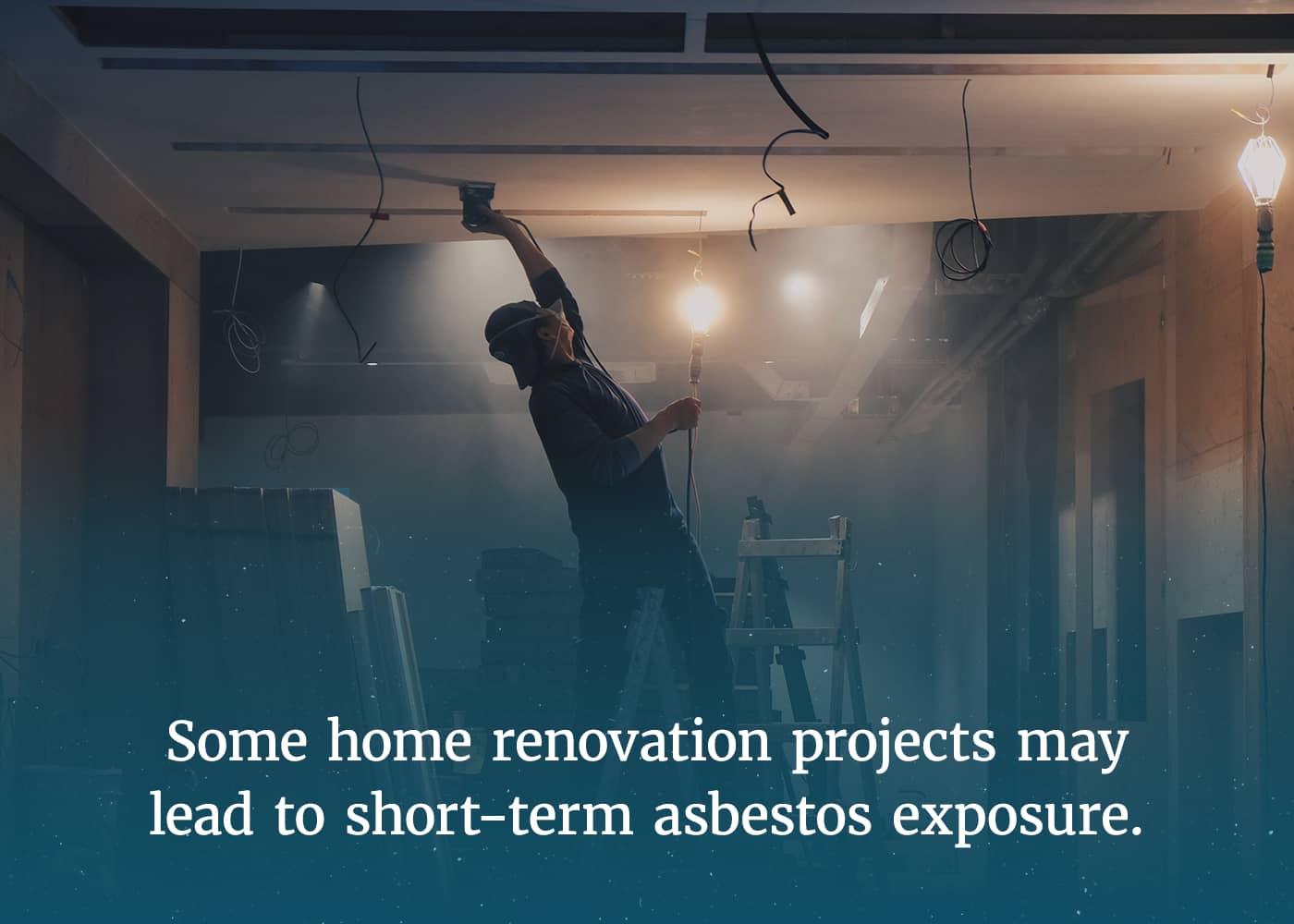01. What Is Short-Term Exposure?
What Is Short-Term Asbestos Exposure?
Short-term asbestos exposure generally refers to either a brief, one-time asbestos exposure or multiple exposure incidents occurring over a few days.
In general, short-term exposure to asbestos dust or asbestos-containing materials poses a relatively low health risk. Comparatively, individuals face a higher risk of developing health issues from chronic or long-term asbestos exposure. However, there is a risk of developing serious illnesses, such as asbestosis and mesothelioma, following short-term exposure to high levels of asbestos.
Short-Term Asbestos Exposure vs. Long-Term Asbestos Exposure
Long-term asbestos exposure is defined as regular exposure to asbestos-containing materials or asbestos dust over an extended period. Examples of long-term exposure include high-risk occupations or continued secondary exposure to a family member working around asbestos.
Individuals who worked daily in environments contaminated with asbestos would have experienced long-term exposure. For example, some teachers in Philadelphia public schools experienced long-term exposure due to the high levels of asbestos in school buildings.
In general, long-term exposure is more dangerous than short-term exposure. However, short-term exposure events involving high levels of asbestos, such as 9/11, can be equally harmful as long-term exposure.
02. Dangers of Short-Term Exposure
How Dangerous Is Short-Term Exposure to Asbestos?
Any amount of asbestos exposure is considered dangerous. The risks of serious illness are greater for individuals exposed to high levels of asbestos. Those individuals face a higher risk even if that exposure occurs over a short period. If a person experiences many short-term exposure events over time, even at a low level, they may also be more at risk of developing an asbestos-related illness.
Several factors contribute to an individual’s level of risk from short-term asbestos exposure, including:
- Ventilation in the exposure area
- Use of the proper personal protective equipment
- Containment of the asbestos within a material, such as flooring tiles
- If the asbestos was friable (crumbled or easily becomes airborne)
- If the individual has any pre-existing health issues
Resources for Mesothelioma Patients
03. Cancer Risk
Can One-Time Exposure to Asbestos Cause Cancer?
One-time exposure to asbestos can cause diseases, including mesothelioma cancer. Researchers have found repeated exposure to asbestos increases the risk of developing asbestos-related cancers.
The risk to individuals who have a one-time exposure to asbestos is generally lower compared to long-term or repeated exposure. It should be noted, however, any amount of asbestos exposure can cause a related disease.
How Much Asbestos Exposure Causes Cancer?
No level of asbestos exposure is completely risk free. All individuals who come into contact with asbestos face an increased risk of developing asbestos-related cancer compared to those who have never been exposed to asbestos.
The best way to reduce the risk of asbestos illness is to completely avoid all exposure.
04. Preventing Exposure
How to Prevent Asbestos Exposure
In the United States today, there are laws and regulations to protect individuals from asbestos exposure. The Environmental Protection Agency (EPA) and Occupational Safety and Health Administration (OSHA) have enacted federal regulations to protect people in their homes, schools and jobsites.
To further reduce asbestos exposure risk, individuals should:
- Consult with a licensed asbestos inspector before any demolition or renovation work on all structures built before 1980.
- Hire an asbestos remediation company to remove any asbestos-containing materials.
- Avoid old industrial sites, abandoned schools and other buildings that could contain asbestos.
- Avoid contact with soil in areas with high levels of naturally occurring asbestos.
- Keep furnace filters clean.
- Vacuum carpeted surfaces with a vacuum equipped with a HEPA filtration system.
Individuals who suspect they have experienced asbestos exposure, even briefly, should consult with their primary care physician. Health care providers can monitor for signs and symptoms of asbestos illness.










